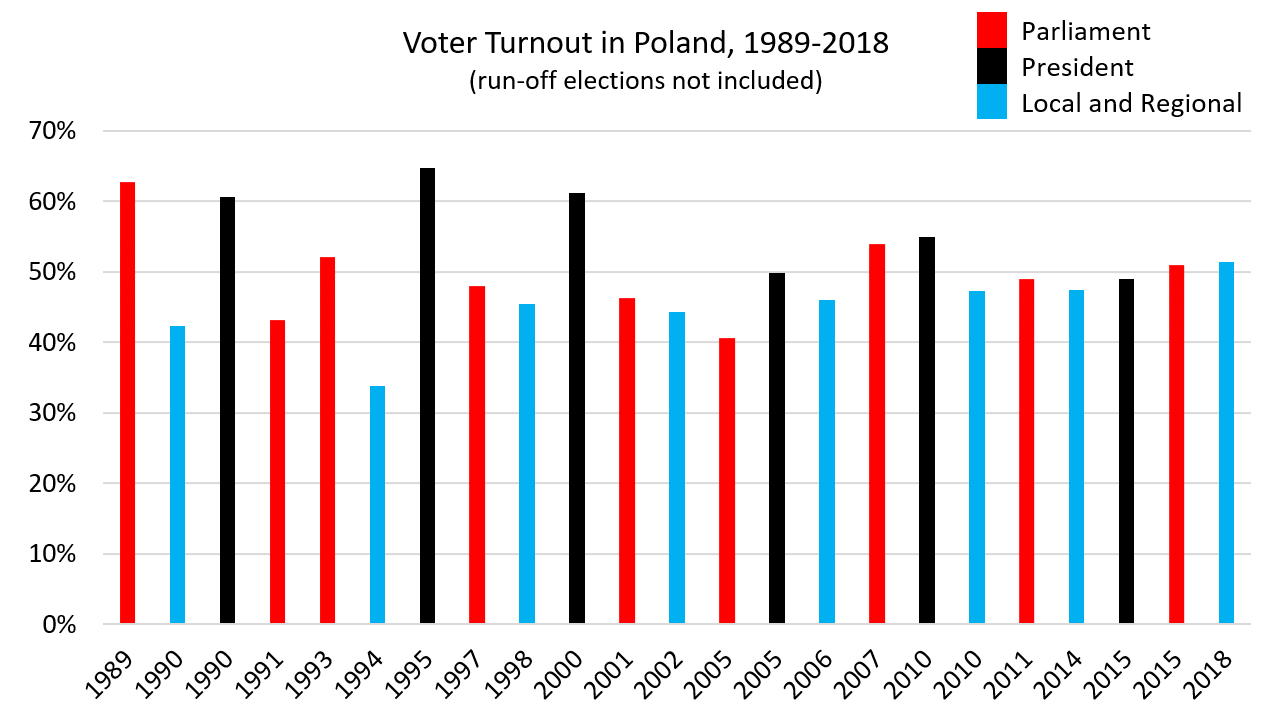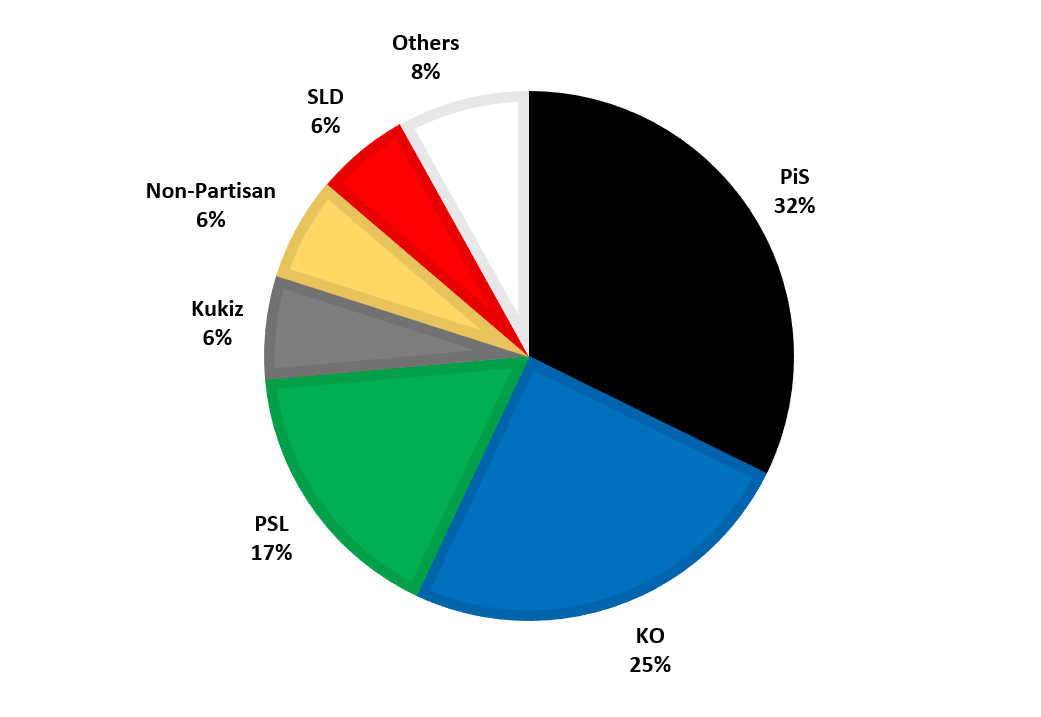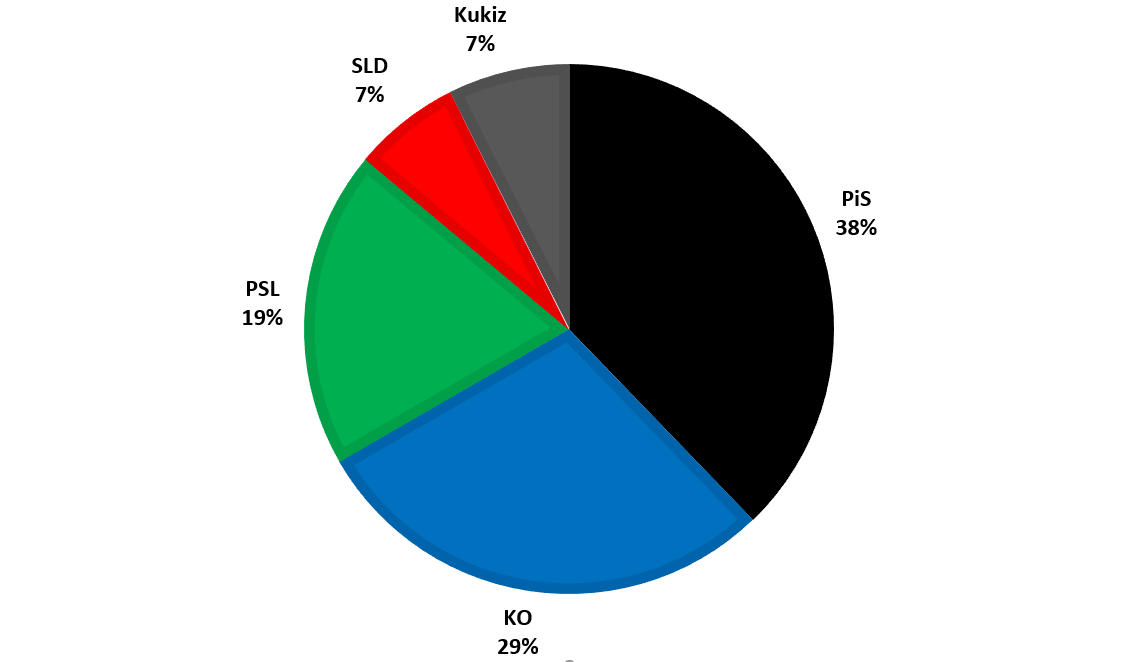Exit Poles
Exit Poles
The awful pun in the headline was too obvious to pass up. My apologies.
Voting has concluded for local and regional elections in Poland. Official results won’t be available until Monday or Tuesday, but the exit polls provide us with a general sense of what happened. Turnout was extraordinary, at 51.3%. That’s more than any other local election in Polish history, and even more than most parliamentary elections.

Some of the headlines right now (11:00 p.m. Polish time) are proclaiming that Jarosław Kaczyński’s party, Law and Justice (Prawo i Sprawiedliwość, or PiS) has won most of the regional assemblies [sejmiki wojewódzkie], taking nine to the opposition’s seven. Similar language is being used to describe the overall partisan breakdown of the vote on a national level—a symbolic accounting only, since this wasn’t a national election. Technically this is accurate, but only if we define “win” as “get more votes than any other party.” True, that’s a definition that makes sense in a zero sum game, but it has no relevance here.

In this chart, KO is the Koalicja Obywatelska [Civic Coalition], an alliance of center-right and center-left parties formed just for this election. PSL is the Polskie Stronnictwo Ludowe [Polish Peasant’s Party], an agrarian party in staunch opposition to PiS. Kukiz is the ill-defined right-wing party formed by the former rock star Paweł Kukiz, and it’s the only group that would likely collaborate with PiS. The Non-Partisan Movement is a loose coalition of local government officials who wanted to focus on issues specific to their town or region, and avoid the poisonous partisanship of national politics. SLD [Sojusz Lewicy Demokratycznej, or Union of the Democratic Left] is the remnant of the post-communist party created in the aftermath of the fall of communism in 1989.
Broken down by województwa, PiS did indeed come first in nine of Poland’s sixteen regions, but it hasn’t yet been announced what exact percentage they got in each of their victories.

But this picture is misleading. In all likelihood, PiSwill be unable to gain control unless they have an absolute majority, and with less than a third of the votes nation-wide, it’s hard to imagine that they’ll achieve 51% in more than a two or three regions. For comparison, in 2014 they came first in five regions, but could only control one.
To put these results in perspective, if we applied the rules for the national sejm [parliament] to today’s results, we’d end up with something like this (I’m eliminating the non-partisans, because as a coalition movement they would need 8% to enter the sejm on a national level):

In other words, with these figures, PiS would be soundly defeated, and unable to govern even with Kukiz as a coalition partner. This is wildly hypothetical, because local elections have very different dynamics than national ones. For example, not even the most ardent partisans of PSL believe that they will get anything close to today’s result in elections to the sejm. On the other hand, aside from SLD, the left did not even try to compete in these local elections, but they won’t be so passive next year. How successful they are will play a huge role in determining the ultimate outcome of this contest.
Today’s grim result for Mr. Kaczyński is reinforced by his party’s catastrophic showing in nearly all of Poland’s major cities. As I wrote yesterday, PiS was not expected to win any of the mayoral races for the largest urban centers, but they did even worse than expected. In most cases, there won’t even be a need for a second round. It seems that the opposition has won outright in Warsaw, Lublin, Łódź, Poznań, Wrocław, and Białystok. A second round will be necessary in Gdańsk, Kielce, and Kraków, and the opposition candidates are favorites to win all three. Only in Katowice did a candidate backed by PiS win, and that is only because they decided to endorse the popular incumbent mayor, even though he is not a member of their party. Perhaps the most humiliating defeat of the night came in Łódź, where Hanna Zdanowska got 70% of the vote despite attempts by PiS to remove her from office in 2016 based on trumped-up charges of corruption. Or maybe that prize would go to Krzysztof Żuk’s victory with 60% of the vote in Lublin, a city in the otherwise conservative southeastern party of the country. To be sure, Żuk is himself a very conservative politician, but he is a member of Civic Platform and a firm opponent of the PiS regime. Rafał Trzaskowski’s victory in Warsaw came with only 54% of the vote, but the PiS candidate, Patryk Jaki, got only 31% (with the rest going to a variety of minor party or independent candidates). Jaki had once been a rising star within his party, aligned closely with the powerful Justice Minister, Zbigniew Ziobro, so this result will have consequences in PiS’s internal power dynamics.
In a post-election interview Kaczyński said “we are having a good night. We are happy.” Well, no: this is a bad night for PiS, and an encouraging result for those who hope to turn Poland away from the authoritarian path it has been on since 2015. Having said that, keep in mind that everything I’ve written here is based on the exit polls. These were conducted by the respected international firm IPSOS, based on a massive data set collected at 1,160 randomly selected polling stations all over the country. So it is unlikely that the official results will differ much from these preliminary figures — assuming, of course, that those results are accurately registered. I’m more optimistic than I was yesterday, because normal PR “spin” will be enough to draw a picture of a PiS victory for the government’s propaganda mouthpieces, making more heavy-handed falsification unnecessary. Still, I’ll breathe easier after we get the official results.